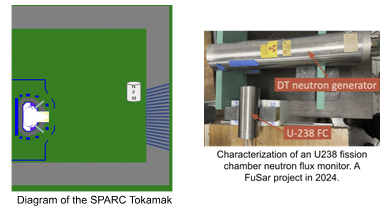Undergrad Education / Undergraduate Research Opportunity Program (UROP) / Characterization of BF3 Neutron Flux Monitors for SPARC Tokamak Fusion Power Measurements
Fusion reactions in the SPARC tokamak1, Deuterium-Tritium (DT) and Deuterium-Deuterium (DD) reactions, produce neutrons. These fusion neutrons are of great importance for fusion plasma diagnostics. Neutron flux monitors (NFM) are one of the fusion neutron diagnostic systems. NFM measures the neutron flux in the tokamak hall and converts the measurement to fusion power through calibration2. This project focuses on characterization of one of the NFMs proposed for SPARC: BF3 proportional counter (PC). BF3 PCs detect neutrons by detecting the charged ions released by 10B neutron absorptions. 10B is most effective in absorbing slow neutrons, while fusion neutrons are fast neutrons (14.1 MeV from DT and 2.45 MeV from DD), so moderating materials such as polyethylene are needed to slow down neutrons locally. Magnetic field effects are known to affect PCs and the field due to SPARC coils has been shown to be near 250 gauss.

Fusion reactions in the SPARC tokamak1, Deuterium-Tritium (DT) and Deuterium-Deuterium (DD) reactions, produce neutrons. These fusion neutrons are of great importance for fusion plasma diagnostics. Neutron flux monitors (NFM) are one of the fusion neutron diagnostic systems. NFM measures the neutron flux in the tokamak hall and converts the measurement to fusion power through calibration2. This project focuses on characterization of one of the NFMs proposed for SPARC: BF3 proportional counter (PC). BF3 PCs detect neutrons by detecting the charged ions released by 10B neutron absorptions. 10B is most effective in absorbing slow neutrons, while fusion neutrons are fast neutrons (14.1 MeV from DT and 2.45 MeV from DD), so moderating materials such as polyethylene are needed to slow down neutrons locally. Magnetic field effects are known to affect PCs and the field due to SPARC coils has been shown to be near 250 gauss.
In this project, you will characterize the performance of the BF3 PC, including its linearity, dynamic range, neutron/gamma discrimination capability, responses to neutrons of different energy, and sensitivity of detector response to a magnetic field.. You will also design & test the flux shaper using moderatoring materials for this PC. Besides experiments, you will also do OpenMC3 simulations to scope the experiment’s setup and preliminary flux shaping material design. Possible extension of this project includes OpenMC simulation of other neutron detectors. Your responsibilities include: Figure out the proper setup for the detector and corresponding electronics. Measure detector responses to different neutron sources (neutron generators and isotropic sources), flux shaping materials, detector alignment, magnetic field, etc. Analyze and post-process experimental data. Run OpenMC simulations of detectors’ responses in both the lab environments and the SPARC tokamak environment.

Connections with fusion experts at MIT and Commonwealth Fusion Systems. Knowledge of cool nuclear radiation instruments, including neutron generators, PC, Geiger counters, amplifiers, preamplifiers, digitizers, etc. Knowledge of the state-of-the-art neutron transport simulation code OpenMC and high performance computing resources at MIT. Possibly present your work in a conference and publish them in a peer-reviewed journal!
1. Creely, A. J. et al. Overview of the SPARC tokamak. Journal of Plasma Physics 86 (2020). 2 Raj, P. et al. Overview of the preliminary design of SPARC’s Neutron Diagnostic Systems. Review of Scientific Instruments (2024). 3 Romano, P. et al. OpenMC: A state-of-the-art Monte Carlo code for research and development. Annals of Nuclear Energy 82, 90–97 (2015).
Head to MIT's UROP site to apply for this opportunity.